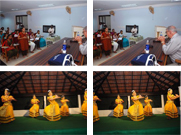School of Environmental Sciences
Priyadharshini Hills P. O
Athirampuzha
Kottayam, Kerala, India-686560
P +91 2732120, +91 9447 391 168
E cta@mgu.ac.in
F +91 481 271 009/02
Priyadharshini Hills P. O
Athirampuzha
Kottayam, Kerala, India-686560
P +91 2732120, +91 9447 391 168
E cta@mgu.ac.in
F +91 481 271 009/02
The International Conference on Membranes (ICM-2013)
on October 3rd to 6th2013
on October 3rd to 6th2013
International Conference on Frontiers of Mass Spectromerty (ICMS 2013)
on September 6th to 9th 2013
on September 6th to 9th 2013
Second International Conference on Advanced Oxidation Processes (AOP 2012)
on October 5th to 8th 2012
on October 5th to 8th 2012
Reserach
Research Interests
Advanced Oxidation Processes (AOPs) for the degradation of Environmental Pollutants: AOPs make use of the involvement of a highly oxidizing species like hydroxyl radical and its subsequent oxidative degradation reaction with organic water pollutants (mainly pharmaceuticals and personal care products (PPCPs), pesticides, and substituted phenols). The main AOPs include Ultrasound, Fenton, photolysis (UV & VIS), photocatalysis using TiO2 and radiolysis are generally being used. In addition, Zerovalent iron nanoparticle is yet another system used for similar degradation studies. The kinetics of reaction and the spectroscopic investigation of the short lived intermediate radicals in all these reactions are monitored by Pulse radiolysis technique. The stable intermediate and final products of the degradation are monitored by HPLCs, LC-MS, UPLC-Q-TOF-MS etc. The extent of mineralisation are being studied by TOC and IC. Scanning of Emerging Pollutants in water and soil: Emerging pollutants include pesticides, pharmaceuticals and personal care products (PPCPs), nanoparticles etc. Our present work involves the scanning of pesticides and many of the pharmaceutically active compounds (antibiotics and veterinary medicines) in backwaters and rivers in Kerala. Most of the scannings are being performed using high resolution mass spectrometry. Some of the pesticides in soil matrix are also monitored using this technique.
Air Pollution Monitoring: Air pollution monitoring is another thrust area of the group. This involves the detection and quantification of various oxides of sulphur, nitrogen, and carbon, Volatile Organic Compounds (VOCs), particulates, toxic metals etc. Both extraction methods and direct sampling method (thermal desorption technique) coupled with GC-MS and LC-MS are utilised as experimental tools.
Development of nanomembrane based Environmental Sensors for pollutants: Nanomembrane fabricated from biopolymers that have intrinsic fluorescence can sense air pollutants such as hydrogen peroxide upto pico molar concentrations. Ovalbumin immobilized nanomembranes is too promising in sensing mercury and nitro compounds as well.
Membrane technology for water purification: Multilayer nano-membranes (biodegradable synthetic membranes) are prepared using polyelectrolytes. Textile and papermill effluents can be treated with such membranes for removing color and COD. This is expected as a superior technology compared conventional methods
Radiation and Photo- induced modifications of DNA and related compounds: The genetic material, DNA, undergoes constant damages due to both internal and external factors. It undergoes nearly 10,000 damages in human body every day. Radiation induced damages are due to direct deposition of energy and to indirect effect from water derived free radicals. We investigate the damage induced by both low LET and high LET radiation using steady state and pulse radiolysis techniques. Photochemical changes are also being studied. Charge transport in DNA is another important phenomena which is extensively being investigated in our group using Femtosecond spectroscopy.
Computer based theoretical calculations for free radical reactions: A great deal of information on the probable reaction sites and energy channels in the free radical chemistry of organic compounds can be obtained using Density Functional Theory (DFT) based theoretical calculations. The DFT calculations are carried out with Gaussian 03 suite of programs by employing B3LYP method using the 6-31+G(d,p) basis set.
Experimental tools : Pulse radiolysis, Laser flash photolysis, Time-resolved spectroscopy, Steady state radiolysis and photolysis, HPLC, HPTLC and other chromatographic techniques, UV-VIS spectrometry, GC-MS, LC-MS, LC-Q-TOF-MS, Highcomputing systems etc
Selected Publications (representative)
Home | Biography | Publications | Our Lab | News | Events | Erudite | SECAS | Research
Group | Collabrotions | Photos | Contact
Group | Collabrotions | Photos | Contact
| CTAMGU © 2012 | Design & Developed By : ITS Developers |


